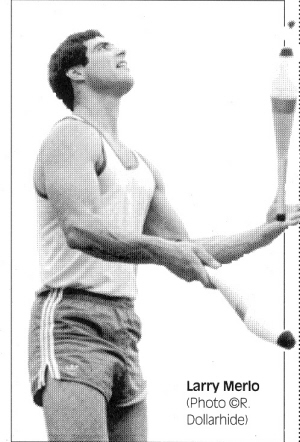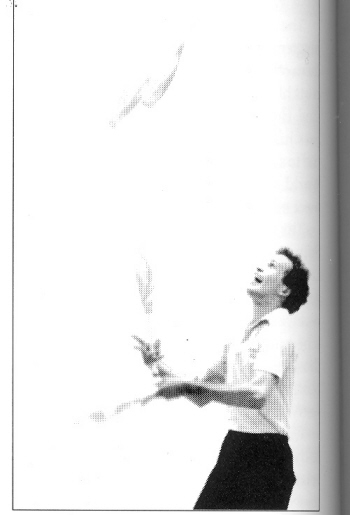
Larry Merlo (photo (C) R. Dollarhide) |

Demetrius Alcarese (photo (C) R. Dollarhide) |
Page 12 Fall 1991
|
The Academic Juggler
PICTURE THAT! By Arthur Lewbel Most
photographs of juggling show objects scattered more or less randomly
in the air, but occasionally something odd happens. In a picture of
an ordinary cascade objects may be neatly arranged in pairs in the
air, or clubs may be all horizontal or all vertical at the same
time. Why does this happen?
Start with a three ball cascade, numbering the balls in the order that they are originally thrown. When ball two is at the top of its are, ball three is being thrown and ball one is being caught. If a picture is taken when ball three is just as close to one hand (on the way up) as ball one is to the other hand (on the way down), the resulting photo will have a single ball on top and two in a horizontal pair near or in the hands.
A
similar effect can happen with any number of balls. Consider a
five ball cascade that was started with 3 balls in the right hand
and two in the left. When ball three (on its way to the left from
the right) is at the top of its are, ball one is being caught in the
left hand and ball five is leaving the right, so balls one and five
form a horizontal pair near or in the hands. In between are balls
two and four. They will also be in a horizontal row, with ball two
heading down to the right and ball four going up from the left.
Balls two and four are both the same height because they are both
equally distant from ball three in time, and hence are both equally
distant from the top of the pattern.
In
an N ball (or any object) cascade for any odd N, when one ball is
right at the top of its flight, the remaining balls are arranged in
(N-1)12 horizontal pairs. In each pair, one object is going up, the
other down, and the pairs themselves alternate so that if one pair
has the object on the right going up, then the next pair up has the
object on the left going up.
This
pairing of objects can be seen in the accompanying
photo of Demetrius AIcarese attempting
seven clubs. Notice also the vertical
distances between these pairs of clubs.
The higher up one looks, the closer is
one pair of clubs to the next pair up (or to
the single club on top). This occurs because
adjacent throws are equally spaced from each other in time.
When an object is thrown upward it slows down,
stops at the top of its flight, then speeds up on the way down until
it is caught. So, to be equally
spaced in time the objects need to be closer together vertically
near the top of the flight than near the
bottom.
This
explains pairing, but what about all clubs being vertical at the
same time, like in the photo of Larry Merlo? A mathematically
detailed explanation can be found in ''The Physics of
Juggling," by Bengt Magnusson and Bruce Tiemann (The Physics
Teacher, November, 1989), but the basic idea is simple.
Consider
a three club cascade with single spins. Divide the time between when a
single club is thrown once and when it is thrown again into three
periods (call the time periods A, B, and C), In period A the
club is in the hand. In period B the club makes its first half turn in
the air, and in period C it makes its second half turn. Since this is
a three club cascade with clubs equally spaced in time, when one club
is doing A, another is doing B and the third is doing C. If you take a
photo right in the middle of a time period, the club doing B will be
vertical with its knob down (being in the middle of its first half
turn) while the club doing C will be vertical with its knob up (the
middle of its second half turn), so both of the clubs in the air will
be vertical at the same time. |

Larry Merlo (photo (C) R. Dollarhide) |

Demetrius Alcarese (photo (C) R. Dollarhide) |